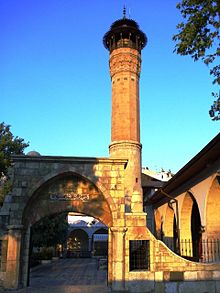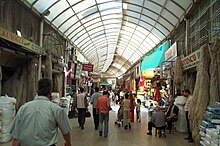Kahramanmaraş
This article needs additional citations for verification. (March 2010) |
Kahramanmaraş | |
|---|---|
 A view of the city center | |
| Country | Turkey |
| Region | Mediterranean |
| Province | Kahramanmaraş |
| Area | |
| • District | 3,017.45 km2 (1,165.04 sq mi) |
| Elevation | 67 m (220 ft) |
| Population (2012)[2] | |
| • Urban | 443,575 |
| • District | 558,664 |
| • District density | 190/km2 (480/sq mi) |
| Time zone | UTC+2 (EET) |
| • Summer (DST) | UTC+3 (EEST) |
| Area code | 0344 |
| Licence plate | 46 |

Kahramanmaraş, originally called Marash (Armenian: Մարաշ), is a city in southeastern Turkey and the administrative center of Kahramanmaraş Province . The city lies on a plain at the foot of the Ahir Dağı (Ahir Mountain) and has a population of 430,000 as of 2011. The region is best known for its production of salep, a flour made from dried orchid tubers, and its distinctive ice cream. It is connected by air to Istanbul and Ankara. Turkish Airlines has daily direct flights from İstanbul and also AnadoluJet operates direct flights from Ankara.
History
Marash was called Germanicia Caesarea (Γερμανίκεια, Germanikeia, in Greek) in the time of the Roman and Byzantine empires. (According to an article published in newspaper Cumhuriyet on 20 December 2010, the first ruins of Germanicia have already been unearthed in the Dulkadiroğulları quarters of the city.[3])
In 645, Germanicia was taken from the Byzantines by the Muslim Arabs, to whom the city was known as Marʻash (Arabic: مرعش [ˈmarʕaʃ ]), which is also the Syriac ܡܪܥܫ). Marash was an important Syrian Orthodox diocese. Mor Dionysius Bar Salibi (died 1171) was its bishop.
Over the next three centuries, Marash belonged to the fortified Arab-Byzantine frontier zone (Thughur) and was used as a base for incursions into Byzantine-held Asia Minor by the Arabs. It was destroyed several times during the Arab-Byzantine Wars. It was rebuilt by the Umayyad caliph Muawiya I and was expanded ca. 800 by the Abbasid caliph Harun al-Rashid. The city was also controlled by the Tulunids, Ikhshidids and Hamdanids before the Byzantines under Nikephoros Phokas recovered it in 962.
After the defeat of Emperor Romanos IV Diogenes at the Battle of Manzikert in 1071, Philaretos Brachamios, a former Byzantine general, founded a principality centred on the city, which stretched from Antioch to Edessa.
Germanikeia was captured by Baldwin I of Jerusalem in 1098 during First Crusade and was part of County of Edessa. It was an important centre during Crusaders rule. According to the Chronicle of Matthew of Edessa, it was destroyed by an earthquake and 10,000 people were killed, which is probably an exaggeration. In 1100, it was captured by Danishmends and by Seljuks in 1103. But in 1107 Crusaders retook it with aid from Byzantine. In 1135, Danishmends besieged Germanikeia unsuccessfully but they captured it next year. However, Crusaders retook it in 1137.[4] Baldwin of Germanikeia died in a war in 1146. He was trying recover Edessa Nur ad-Din Zangi which had taken the side of Joscelin II of Edessa. His successor, Reynald of Germanikeia also died in battle of Inab against Zengids and Mesud I, Sultan of Rum took the city in 1149.
Marash was captured by Zengids in 1151 but recaptured by Seljuks in 1152. But, Maraş was recaptured by Zengids in 1173 and was left to Mleh, his collaborator. Marash passed to Seljuks in 1174 and to Ayyubids in 1182.

Kaykhusraw I, Sultan of Rum captured Marash in 1208. Seljuk rule lasted to 1258. In 1258, Maraş was captured by the Armenian Kingdom of Cilicia, following the war with the Ilkhanate. Marash was captured by Al-Ashraf Khalil, Mamluk Sultan in 1292. But, it was recaptured by Hethum II, King of Cilician Armenia in 1299. Marash finally taken by the Mamluks in 1304.
Marash was ruled by Dulkadirs, as vassals of Mamluks between 1337-1515 before being annexed to the Ottoman Empire. In the early days of Ottoman rule (1525-6) there were 1,557 adult males (total population 7,500), at this time all the inhabitants were Muslims.[5] Later a substantial number of non Muslims immigrated into the city mainly in the 19th century.[6] Ottoman rule, the city was at first centre of Eyalet of Dulkadir (Also called Eyalet of Zûlkâdiriyye) before first half of 19th century, later in was a sanjak centre in the Vilayet of Aleppo before 1918. It was controlled first by British troops between 22 February 1919 and 30 October 1919, after by French ones after signing Armistice of Mudros. It was occupied by the Turkish National Movement after Battle of Marash in 13 February 1920. Afterward a wholesale massacre of Armenian civilians took place.[7] Roving Turkish bands threw kerosene-doused rags on Armenian homes and laid a constant barrage upon the American relief hospital.[8] The Armenians themselves, as in previous times of trouble, sought refuge in their churches and schools.[9] Women and children found momentary shelter in Marash's six Armenian Apostolic, three Armenian Evangelical churches and in the city's sole Catholic cathedral. All the churches and eventually the entire Armenian districts were put to flames.[10][11][12] When the 2,000 Armenians who had taken shelter in the Catholic cathedral attempted to leave, they were cut down by Turkish rifle and machine gun fire.[13] Early reports put the number of Armenians dead at no less than 16,000, although this was later revised down to 5,000–12,000.[14][15]
In 1973, Marash had its name changed to Kahranmanmaraş when the Turkish government added "Kahraman" to the name.
In December 1978, Kahramanmaraş was the site of a massacre of leftist Alevis. A Turkish nationalist group, the Grey Wolves, incited the violence that left over 105 dead. The incident was important in the Turkish government's decision to declare martial law, and the eventual military coup in 1980.[16]
| Year | Population[17] |
|---|---|
| 1525-6 | 7500 |
| 1564-5 | 13500 |
| 1914 | 32700 |
| 1927 | 25672 |
| 1940 | 27744 |
| 1945 | 33104 |
| 1950 | 34641 |
| 1960 | 54447 |
| 1970 | 110761 |
| 1980 | 178557 |
Climate
Kahramanmaraş has a mediterranean climate. Summers are hot and dry with an average of 35°C (95°F) but can go higher than +40°C (104°F). The highest recorded temperature being 45.2°C (113.36°F) on 30 July 2007. Winters are cold and damp with temperatures ranging from 0-5°C (32-41°F). The coldest temperature recorded was -9.6°C (14.72°F) on 6 February 1997.
| Climate data for Kahramanmaraş | |||||||||||||
|---|---|---|---|---|---|---|---|---|---|---|---|---|---|
| Month | Jan | Feb | Mar | Apr | May | Jun | Jul | Aug | Sep | Oct | Nov | Dec | Year |
| Record high °C (°F) | 18.7 (65.7) |
21.8 (71.2) |
29.2 (84.6) |
36.0 (96.8) |
38.0 (100.4) |
42.0 (107.6) |
45.2 (113.4) |
44.4 (111.9) |
41.3 (106.3) |
37.2 (99.0) |
27.2 (81.0) |
24.0 (75.2) |
45.2 (113.4) |
| Mean daily maximum °C (°F) | 9.1 (48.4) |
10.9 (51.6) |
15.7 (60.3) |
21.1 (70.0) |
26.7 (80.1) |
31.9 (89.4) |
35.6 (96.1) |
35.9 (96.6) |
32.4 (90.3) |
25.8 (78.4) |
17.2 (63.0) |
10.9 (51.6) |
22.8 (73.0) |
| Mean daily minimum °C (°F) | 1.3 (34.3) |
2.2 (36.0) |
5.6 (42.1) |
9.9 (49.8) |
14.2 (57.6) |
18.9 (66.0) |
22.1 (71.8) |
22.2 (72.0) |
18.4 (65.1) |
12.9 (55.2) |
6.8 (44.2) |
3.1 (37.6) |
11.5 (52.6) |
| Record low °C (°F) | −7.8 (18.0) |
−9.6 (14.7) |
−7.6 (18.3) |
−0.6 (30.9) |
5.0 (41.0) |
11.0 (51.8) |
15.6 (60.1) |
16.0 (60.8) |
8.6 (47.5) |
2.2 (36.0) |
−4.4 (24.1) |
−7.6 (18.3) |
−9.6 (14.7) |
| Average precipitation mm (inches) | 125.4 (4.94) |
112.3 (4.42) |
94.8 (3.73) |
76.1 (3.00) |
39.3 (1.55) |
7.4 (0.29) |
2.5 (0.10) |
1.5 (0.06) |
9.3 (0.37) |
53.1 (2.09) |
93.5 (3.68) |
129.2 (5.09) |
744.4 (29.32) |
| Average rainy days | 12.4 | 12.2 | 12.3 | 11.6 | 8.1 | 2.7 | 1.5 | 1.3 | 2.7 | 6.7 | 9.1 | 12.1 | 92.7 |
| Mean monthly sunshine hours | 108.5 | 117.6 | 173.6 | 204 | 263.5 | 312 | 341 | 319.3 | 273 | 213.9 | 135 | 102.3 | 2,563.7 |
| Source: Devlet Meteoroloji İşleri Genel Müdürlüğü[18] | |||||||||||||
Industry

Some of the internationally-known ice-cream companies like MADO, Yaşar Pastanesi, EDO and Ferah Pastanesi started their business in this ice-cream city and thousands of people visit Kahramanmaraş, just because of its ice-cream (dondurma in Turkish).
The town was (and may still be) the home town of the 172nd Armoured Brigade of the Turkish Second Army.
Sports
The city has a local football team called; Kahramanmaraşspor which plays in the Turkish 2nd Division league. Kahramanmaraşspor plays its home games in Hanefi Mahçiçek Stadium. Some famous Turkish players like Mehmet Özdilek and Kemalettin Şentürk played in Kahramanmaraşspor before transferring to bigger clubs.
Notable natives
- Leo III - Byzantine Emperor (717 - June 18, 741)
- Nestorius - 5th century religious leader
- Karacaoğlan - 17the century Turkish Poet and Ashik
- Senem Ayşe Gençay - Hero of the Turkish Women at the First World War
- Sünbülzade Vehbi - Turkish poet
- Necip Fazıl Kısakürek - Turkish poet and writer
- Aşık Mahzuni Şerif - Turkish folk singer/songwriter
- Kıraç - Turkish singer/songwriter
- Şeref Eroğlu - European and World champion, Olympic medalist wrestler
- George E. White - American missionary and witness to the Armenian Genocide
See also
References
- ^ "Area of regions (including lakes), km²". Regional Statistics Database. Turkish Statistical Institute. 2002. Retrieved 2013-03-05.
- ^ "Population of province/district centers and towns/villages by districts - 2012". Address Based Population Registration System (ABPRS) Database. Turkish Statistical Institute. Retrieved 2013-02-27.
- ^ Cumhuriyet , 20 December 2010 p. 20
- ^ http://www.k-maras.com/a_dos/t_gelisimi.htm
- ^ The Supreme Muslim Council: Islam Under the British Mandate for Palestine, Uri M. Kupferschmidt, page 508
- ^ The Supreme Muslim Council: Islam Under the British Mandate for Palestine, Uri M. Kupferschmidt, page 508-509
- ^ "The Massacre Of Armenians." The Times. 28 February 1920.
- ^ "Eyewitness Tells How Armenians were Massacred." The New York Times. 29 February 1920.
- ^ Hovannisian. "Postwar Contest for Cilicia", p. 509.
- ^ Template:Fr icon Muré, Materne (1921). Un épisode de la tragédie arménienne: le massacre de Marache (février 1920). Brussels: Société Belge de Libraire.
- ^ Kerr. The Lions of Marash, pp. 95–142.
- ^ Sahakyan. Turkish-French Relations, pp. 150–52.
- ^ Hovannisian. Republic of Armenia, p. 41.
- ^ Documents on British Foreign Policy, vol. vii, p. 303.
- ^ Kerr. The Lions of Marash, p. 196.
- ^ Zurcher, Eric. "Turkey: A Modern History". I.B. Tauris: London, 1993: 276-277
- ^ The Supreme Muslim Council: Islam Under the British Mandate for Palestine, Uri M. Kupferschmidt, page 508 - 509
- ^ "İl ve İlçelerimize Ait İstatistiki Veriler- Meteoroloji Genel Müdürlüğü". Meteor.gov.tr. Retrieved 2013-01-01.
External links
This article's use of external links may not follow Wikipedia's policies or guidelines. (July 2011) |
- Kahramanmaraş News
- Kahramanmaraş Communication Portal
- Kahramanmaraş Daily Information W ebsite
- Kahramanmaraş Official Government Website
- Kahramanmaraş Town Office Website
- Kahramanmaraş Investment Support Office Website
- Kahramanmaraş Town Office Website - City Transport ation
- Kahramanmaraş Town Police Office Website
- Kahramanmaraşspor Unofficial Website
- Kahramanmaraş Web Design


